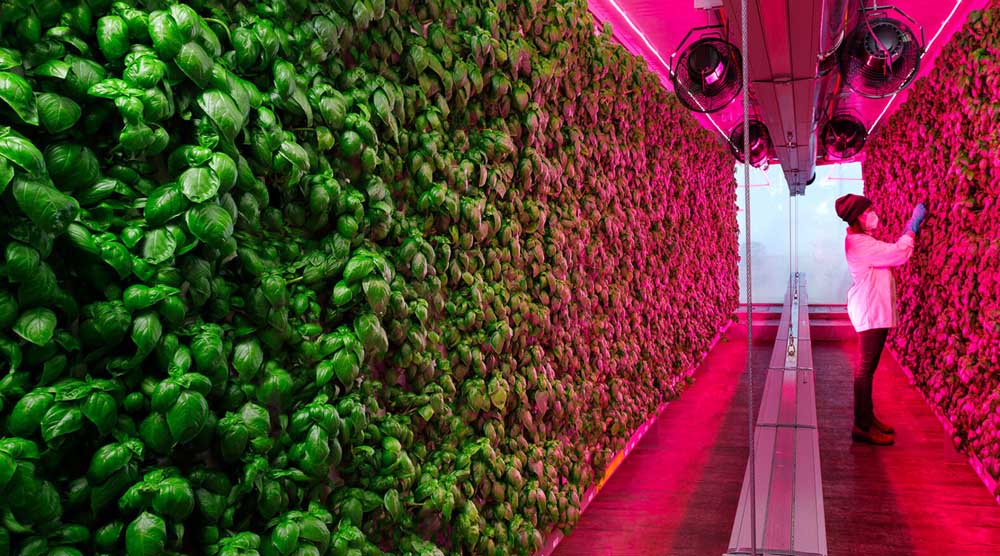Researchers work to figure out farming in the dark
Published 7:00 am Saturday, May 11, 2024

- A spectrum experiment at Square Roots is evaluating the effects of light treatment on the growth of basil plants. The company is developing plants that need little or no light to thrive.
Indoor farming, with its controlled environment, holds a lot of advantages over conventional farming. But there are also drawbacks, including the cost of lighting needed to grow the plants.
One advanced indoor farming company hopes to remove light from the process — essentially growing food in the dark.
Trending
New York-based Square Roots was launched in 2016 by entrepreneurs Kimbal Musk, brother of Elon Musk, and Tobias Peggs, the company’s CEO.
Capital Press wanted to know more about the company and its goals and asked Peggs a series of questions.
His answers have been edited for space and clarity.
CP: What is the company trying to accomplish?
Peggs: Square Roots was built to accelerate agricultural research for our partners. We help our partners “grow their brightest ideas with indoor farming.” A lot of the programs across our platform today are focused on helping future-proof agriculture-dependent businesses, government agencies and non-governmental organizations as they respond to the climate crisis.
CP: What led to Square Roots?
Trending
Peggs: When I moved to the U.S. from the United Kingdom in the mid-2000s, I met Kimbal Musk and joined him at a social media startup company called OneRiot. That company was acquired by Walmart in 2011, and I worked there for a year building mobile commerce services for grocery shoppers. That’s when I got curious about food systems .
Kimbal is obviously well known for his work at Tesla, SpaceX, etc., but after a skiing accident where he was almost paralyzed, he decided to focus a lot of his time on his restaurant company, The Kitchen. After my time at Walmart, I worked with him at The Kitchen for a year and was able to study local food systems, as Kimbal had created a playbook in which all of the restaurants in that group sourced from local farmers.
We spent a lot of time looking at scalable, technology-enabled ways to bring more local food to more people — trying to figure out how we could offer the goodness of local food but use technology to do that everywhere at Walmart-type scale.
From those conversations came the original idea for Square Roots — a network of indoor farms where we could grow delicious food all year round in controlled climates and locate all those farms in the same neighborhood as the consumers.
We succeeded in building a commercial vertical farming brand and partnering with Gordon Food Service — one of the biggest food distributors in the country — to co-locate farms at their distribution centers.
Along the way, we built up a sophisticated layer of proprietary software and systems, and we tested over 200 different crop varieties . That opened our eyes to how our technology and processes could benefit the wider world of agriculture. So we have now opened up our platform to partner with some of the biggest names in food and research, helping them tackle some of the biggest challenges in agriculture.
CP: Where does the company operate?
Peggs: We have opened five production-scale farms across the Midwest. Our corporate headquarters is in Brooklyn, and we have 29 employees.
Commercial organizations partner with Square Roots to develop differentiated produce, lock in guaranteed supply, accelerate trials for new varieties and deliver on sustainability commitments.
CP: Why do you want to remove light from indoor farming?
Peggs: Indoor farms’ ability to grow fresh, nutritious food, all year round, in any location, irrespective of outdoor climate, has obvious appeal. The farms use less water and land than conventional farms. And if located close to the consumer, they support shorter supply chains, reducing food miles and reducing associated carbon emissions from transport while being able to deliver same-day, farm-fresh produce to customers.
But to date, the solution has been very energy-intensive — primarily driven by lighting needs — which translates into high production costs.
Of course, the industry is constantly trying to reduce costs by improving operational efficiencies or adopting automation. While those gains are important, they also have a tendency to be somewhat incremental. The reality is that as an industry, we must make step changes in reducing energy needs to significantly bring down costs — not to mention carbon emissions.
That’s a big driver behind our program in heterotrophic farming — where plants effectively grow in the dark. The program aims to demonstrate that light can be removed from a commercial indoor vertical farming system. All the benefits of indoor farming remain, but the system can now operate with radically reduced energy needs. This translates directly into significantly lower production costs and associated carbon dioxide emissions.
CP: How do you plan to do that?
Peggs: To enable this new approach, Square Roots is working with CRISPR gene-edited plants that add biomass by uptaking carbon through their root systems rather than relying on photosynthesis under light. Plants do this naturally at their early stages, and this gene edit simply maintains that natural capability for the plant’s full lifecycle.
We use acetate as the carbon source, which is a vinegar-like substance added to the irrigation water. This heterotrophic plant growth adds up to plants growing in the dark — or certainly with a lot less light, and therefore significantly less energy and cost.
The underlying science was initially developed by Robert Jinkerson, a specialist in artificial photosynthesis at the University of California-Riverside, in conjunction with Feng Jiao, a chemist at the University of Delaware. They have been very successful with lab-scale trials in sustainable acetate production and heterotrophic plant growth.
Now the Square Roots platform is being used to learn how to grow heterotrophically at production scale. The ultimate aim of the program is to develop a blueprint for low-cost, low-carbon indoor farms, specifically designed to maximize the benefits of this technique — which could unlock the full potential of vertical farming for new crops and communities around the world.
This work is supported by a grant from the Bill and Melinda Gates Foundation. The foundation has invested significantly in programs to help ensure global food security, with a specific focus on low- and middle-income countries.
Traditional farms in these regions are likely to face outsized risk due to climate change and will also face big pressures due to population growth. The inherent climate-resilience and scalability of indoor farming means it should play a key role in the strategy to ensure global food security.
But that will only happen if its energy needs are reduced. So a breakthrough with heterotrophic farming would make indoor farming considerably more viable for low- and middle-income communities — where arguably the technology solution is most needed.
CP: When do you plan to incorporate this technology?
Peggs: Multiple trials are already running on our platform where we’re growing leafy greens and tomatoes heterotrophically, allowing us to compare the resource needs of this method versus indoor photosynthetic growth and field farming.
We started with arabidopsis, which is a very bitter green, not really edible, but it’s often used as the model plant in scientific experiments. It is easy to gene edit, and there is a significant body of research supporting its use. It was the first crop edited for acetate utilization by Jinkerson and his team, and its short growing time allows for faster cycles of research and analysis. The learnings are then being applied to trials with longer growing, higher calorie crops.
The second phase of the program is running trials on lettuce. Since lettuce is the most commonly grown crop in vertical farms, we have good benchmark data to compare the energy resources utilized between photosynthetic growth and heterotrophic growth. We can also compare that readily with field-grown varieties.
Lettuces also have relatively fast growth cycles, so we can rapidly test multiple grow-recipes to capture yield data with different levels of acetate and light, including zero light.
We will also be looking closely at crop quality to determine market suitability of the end product. The science here is obviously very cool, but we have to ensure that the technique results in a product that is delicious, nutritious and that people want to eat.
The third phase will be growing so-called “space tomatoes.” This variety has already been edited to produce maximum fruit quickly in a compact structure. This plant is well suited to high-density growing in vertical farms. Tomatoes will allow us to progress to understanding light levels necessary for fruiting and flowering in a heterotrophic system. Also, tomatoes are an important global source of calories, representing 15% of total vegetable production.
CP: If successful, could this be a game-changer?
Peggs: The long-term objective is to tackle high-calorie, high-nutrient, staple foods — which don’t make economic sense in vertical farms today but could with reduced energy costs. From our initial analysis, we believe that potato and cassava can be readily adapted to efficiently grow indoors using this technique.
Additionally, because our platform is modular, we can run trials with different plants and even different grow systems in the same facility at the same time. For example, we might have an aeroponic system for heterotrophic potato trials while we run lettuce trials concurrently in a hydroponic system.
As we extend our learning to other nutrient-dense crops, our platform can seamlessly adapt to accelerate that research.
Agriculture continues to face pressures from climate change and limited resources. At the same time we have to feed a growing population while the reported average age of farmers globally seems to go up another year almost every year.
But if you fast forward beyond the scope of this program, one can imagine a connected network of low-cost, low-carbon indoor farms across low- and middle-income communities run by tech-savvy, data-driven farmers producing staple crops year-round in sustainable and economically viable ways.
We don’t yet know what the optimal farm model will be. Maybe these future indoor farms are not growing plants to full maturity, but perhaps they’re taking advantage of heterotrophic growing, plus perfect climates and high-density planting, to become super-nurseries that produce healthy and hardy starter plans to improve success rates of outdoor farmers and ultimately improve outdoor yields. It’s exciting to think about the possibilities.
CP: Do you have any final thoughts?
Peggs: For too long, indoor farming has positioned itself as a disruptor to agriculture. We think indoor farming would do better helping to solve the big problems for agriculture instead of competing with it. That was a primary driver for setting up the Square Roots research platform. And this heterotrophic growing program is a fantastic illustration of the power of that platform.








